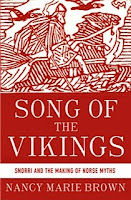Ivory Vikings is a biography of the Lewis chessmen, the famous walrus-ivory chessmen found on the Isle of Lewis in far western Scotland in 1831. While gathering illustrations for my previous book about medieval Iceland, Song of the Vikings: Snorri and the Making of Norse Myths, I was surprised to learn that these chessmen, long considered icons of the Viking Age, had actually been carved over a hundred years later, between 1150 and 1250, during the lifetime of Snorri Sturluson.
According to one theory I read, they may even have been carved by a woman in Iceland whom Snorri knew, Margaret the Adroit, who worked for Bishop Pall of Skalholt, Snorri's foster brother.
In Song of the Vikings, I argued that Snorri was responsible for most of what we know about Norse mythology. I argued that he invented the genre of "saga," which his countrymen in the 13th and 14th centuries developed into the masterpieces of world literature they are now universally acknowledged to be. I included an image of one of the Lewis queens in that book, referring to the theory of their Icelandic origin in a caption. But there was no room in Song of the Vikings to develop the idea that medieval Icelanders may also have been exceptional visual artists as well as world-class writers.
That idea nagged at the back of my mind. I wondered why I'd never heard anything like it before. Was the author of this Iceland theory of the Lewis chessmen a crackpot? I did some basic research and learned that the theory was, in fact, a very old one: Frederic Madden of the British Museum, who was the first person to write about the Lewis chessmen, the year after their discovery on the Isle of Lewis in 1831, concluded that they had been made in Iceland in the 12th century.
And yet, when Icelandic civil engineer and chess aficionado Gudmundur Thorarinsson reintroduced the Iceland theory, he was ridiculed. Alexander Woolf, a professor of medieval studies from the University of St Andrews, was particularly dismissive. Responding to a reporter from the New York Times, he said that Iceland was too poor and backward a place to produce such stunning works of art. "A hell of a lot of walrus ivory went into making those chessmen, and Iceland was a bit of a scrappy place full of farmers," he said, adding, "You don't get the Metropolitan Museum of Art in Iowa."
(Woolf has since retracted his statement. The reporter had caught him off guard. Since meeting Gudmundur and visiting Skalholt in Iceland, Woolf has become a supporter of the Iceland theory.)
Woolf’s comment stung me. Having just spent several years researching and writing about the Iceland of that period, I knew he was wrong. Iceland in the late 12th and early 13th century was at the peak of its Golden Age: rich, independent, and in a frenzy of artistic creation.
 |
| Margret the Adroit by Svala Soleyg |
The Lewis chessmen are the most famous chess pieces in the world. They are considered masterpieces of Romanesque art, among the most important archaeological finds from Scotland and the most popular exhibits at the British Museum. If there was a chance they could indeed have been made by a woman in Iceland around the year 1200, that was a story I needed to tell.
(This story is based on an interview with the Icelandic newspaper Morgunblaðið, published on September 4; an English version was published on Medievalists.net on September 13.)
Read more about Ivory Vikings on my website, http://nancymariebrown.com, or check out these reviews:
"Bones of Contention," The Economist (August 29): http://www.economist.com/news/books-and-arts/21662487-bones-contention
"Review: Ivory Vikings," Minneapolis Star Tribune (August 29): http://www.startribune.com/review-ivory-vikings-by-nancy-marie-brown-the-mystery-of-the-lewis-chessmen/323230441/



Omg I Finally Got Helped !! I'm so excited right now, I just have to share my testimony on this Forum.. The feeling of being loved takes away so much burden from our shoulders. I had all this but I made a big mistake when I cheated on my wife with another woman and my wife left me for over 4 months after she found out.. I was lonely, sad and devastated. Luckily I was directed to a very powerful spell caster Dr Emu who helped me cast a spell of reconciliation on our Relationship and he brought back my wife and now she loves me far more than ever.. I'm so happy with life now. Thank you so much Dr Emu, kindly Contact Dr Emu Today and get any kind of help you want.. Via Email emutemple@gmail.com or Call/WhatsApp +2347012841542
ReplyDelete